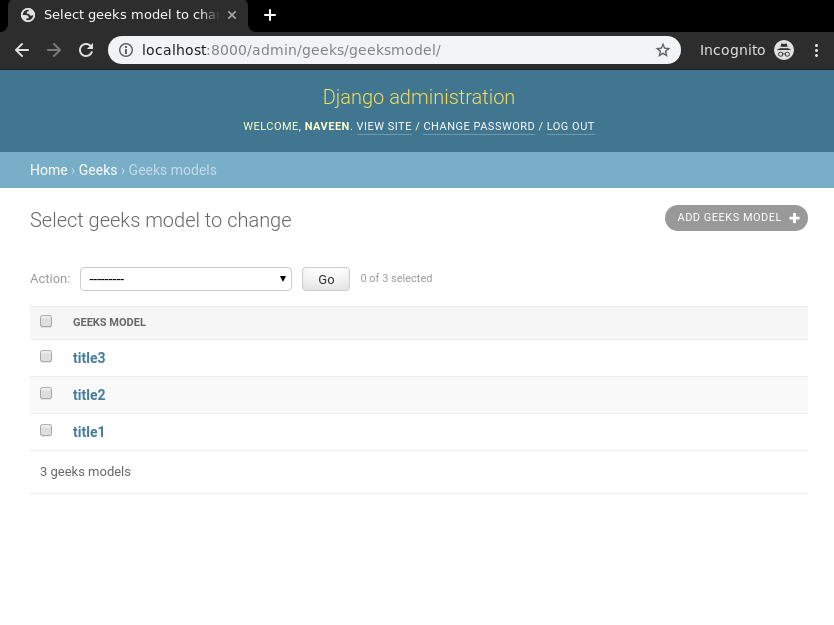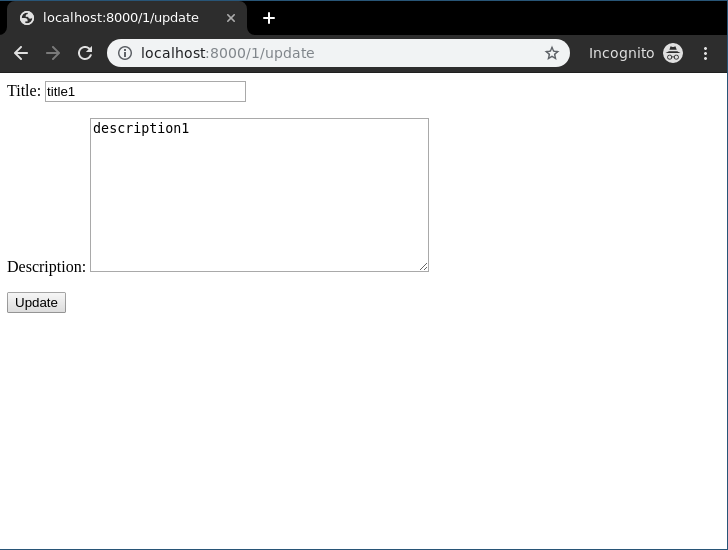Update View - Function based Views Django
Last Updated : 28 Apr, 2025
Update View refers to a view (logic) to update a particular instance of a table from the database with some extra details. It is used to update entries in the database for example, updating an article at geeksforgeeks. So Update view must display the old data in the form and let user update the data from there only. Django provides extra-ordinary support for Update Views but let's check how it is done manually through a function-based view. This article revolves around Update View which involves concepts such as Django Forms, Django Models.
For Update View, we need a project with some models and multiple instances which will be displayed. Basically, Update view is a combination of Detail view and Create view.
Django Update View - Function Based Views
Illustration of How to create and use Update view using an Example. Consider a project named geeksforgeeks having an app named geeks.
Refer to the following articles to check how to create a project and an app in Django.
After you have a project and an app, let's create a model of which we will be creating instances through our view. In geeks/models.py,
Python3 # import the standard Django Model # from built-in library from django.db import models # declare a new model with a name "GeeksModel" class GeeksModel(models.Model): # fields of the model title = models.CharField(max_length = 200) description = models.TextField() # renames the instances of the model # with their title name def __str__(self): return self.title
After creating this model, we need to run two commands in order to create Database for the same.
Python manage.py makemigrations Python manage.py migrate
Now let's create some instances of this model using shell, run form bash,
Python manage.py shell
Enter following commands
>>> from geeks.models import GeeksModel >>> GeeksModel.objects.create( title="title1", description="description1").save() >>> GeeksModel.objects.create( title="title2", description="description2").save() >>> GeeksModel.objects.create( title="title2", description="description2").save()
Now we have everything ready for back end. Verify that instances have been created from http://localhost:8000/admin/geeks/geeksmodel/

Now we will create a Django ModelForm for this model. Refer this article for more on modelform - Django ModelForm – Create form from Models. create a file forms.py in geeks folder,
Python3 from django import forms from .models import GeeksModel # creating a form class GeeksForm(forms.ModelForm): # create meta class class Meta: # specify model to be used model = GeeksModel # specify fields to be used fields = [ "title", "description"]
For Update_view one would need some identification to get a particular instance of the model. Usually it is unique primary key such as id. To specify this identification we need to define it in urls.py. Go to geeks/urls.py,
Python3 from django.urls import path # importing views from views..py from .views import update_view, detail_view urlpatterns = [ path('<id>/', detail_view ), path('<id>/update', update_view ), ] Let's create these views with explanations. In geeks/views.py,
Python3 from django.shortcuts import (get_object_or_404, render, HttpResponseRedirect) # relative import of forms from .models import GeeksModel from .forms import GeeksForm # after updating it will redirect to detail_View def detail_view(request, id): # dictionary for initial data with # field names as keys context ={} # add the dictionary during initialization context["data"] = GeeksModel.objects.get(id = id) return render(request, "detail_view.html", context) # update view for details def update_view(request, id): # dictionary for initial data with # field names as keys context ={} # fetch the object related to passed id obj = get_object_or_404(GeeksModel, id = id) # pass the object as instance in form form = GeeksForm(request.POST or None, instance = obj) # save the data from the form and # redirect to detail_view if form.is_valid(): form.save() return HttpResponseRedirect("/"+id) # add form dictionary to context context["form"] = form return render(request, "update_view.html", context) Now create following templates in templates folder,
In geeks/templates/update_view.html,
HTML <div class="main"> <!-- Create a Form --> <form method="POST"> <!-- Security token by Django --> {% csrf_token %} <!-- form as paragraph --> {{ form.as_p }} <input type="submit" value="Update"> </form> </div> In geeks/templates/detail_view.html,
HTML <div class="main"> <!-- Display attributes of instance --> {{ data.title }} <br/> {{ data.description }} </div> Let's check if everything is working, visithttp://localhost:8000/1/update.

Here you can see the form with data already filled from the instance, Now one can edit this data and update it easily, let's check it out

Hit update and done.
